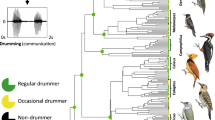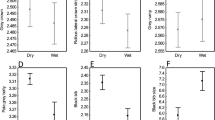Abstract
ANIMALS exhibit a diversity of colour patterns that are commonly used in interspecific and intraspecific communication1–3. Factors influencing the evolution of signals used in communication include the properties of the physical environment in which the signal is generated2–10, the perceptual systems of individuals (such as potential mates or predators) receiving the signal2,3,11–16, and the nature of the information signalled. In warblers of the genus Phylloscopus, species differences in colour patterns are correlated with light intensity of the habitat: brighter species live in darker habitats. I report here two observations that colour patterns function to increase conspicuousness, and are used in intraspecific communication. First, individuals make themselves temporarily more conspicuous by flashing the bright colour patterns in display, and are less conspicuous when not displaying. Second, experimentally increasing conspicuousness of males within a given habitat increases territory size, whereas experimentally reducing conspicuousness results in either a smaller territory or its total loss. Traits used in intraspecific communication are often thought to diverge as a result of variation in perceptual systems2,3,13,15–17. This study shows that variation in the physical environment can cause species divergence, and this will occur whether perceptual systems are variable or relatively constant.
This is a preview of subscription content, access via your institution
Access options
Subscribe to this journal
Receive 51 print issues and online access
$199.00 per year
only $3.90 per issue
Buy this article
- Purchase on Springer Link
- Instant access to full article PDF
Prices may be subject to local taxes which are calculated during checkout
Similar content being viewed by others
References
Burt, E. H. Jr Ornithol. Monogr. 38 (1986).
Ryan, M. J. in Oxford Surveys in Evolutionary Biology (eds Futuyma, D. & Antonovics, J.) 156–175 (Oxford Univ. Press, Oxford, 1991).
Endler, J. A. Am. Nat. 139, sl25–sl53 (1992).
Morton, E. S. Am. Nat. 109, 17–34 (1975).
Ryan, M. J. & Brenowitz, E. A. Am. Nat. 126, 87–100 (1985).
Endler, J. A. Biol. J. Linn. Soc. 41, 315–352 (1990).
Ryan, M. J., Cocroft, R. B. & Wilczynski, W. Evolution 44, 1869–1872 (1990).
Thery, M. Rev. Ecol. (Terre Vie) 45, 215–236 (1990).
Endler, J. A. Vision Res. 31, 587–608 (1991).
Endler, J. A. Ecological Monographs (in the press).
Lande, R. Proc. natn. Acad. Sci. U.S.A. 78, 3721–3725 (1981).
Ryan, M. J. Proc. natn. Acad. Sci. U.S.A. 83, 1379–1382 (1986).
Endler, J. A. & McLellan, T. A. Rev. ecol. Syst. 19, 395–421 (1988).
Ryan, M. J. & Rand, A. S. Evolution 44, 305–314 (1990).
Ryan, M. J., Fox, J. H., Wilcyzynski, W. & Rand, A. S. Nature 343, 66–67 (1990).
Kirkpatrick, M. & Ryan, M. J. Nature 350, 33–38 (1991).
Basolo, A. L. Science 250, 808–810 (1991).
Price, T. J. anim. Ecol. 60, 643–664 (1991).
Williamson, K. The Genus Phylloscopus (British Trust for Ornithology, Oxford, 1974).
Endler, J. A. Evol. Biol. 11, 319–364 (1978).
Richman, A. D. & Price, T. Nature 335, 817–821 (1992).
Felsenstein, J. Am. Nat. 125, 1–15 (1985)
Gaston, A. J. Ibis 116, 432–450 (1974).
Shutler, D. & Weatherhead, P. J. Evolution 44, 1967–1977 (1990).
Rohwer, S. Anim. Behav. 33, 1325–1331 (1985).
Edmunds, M. Defence in Animals (Longman, New York, 1974).
Dunn, J. F. Exposure Manual (Fountain, London, 1958).
Price, T. & Jamdar, N. J. Bombay nat. Hist. Soc. 88, 1–19 (1991).
Author information
Authors and Affiliations
Rights and permissions
About this article
Cite this article
Marchetti, K. Dark habitats and bright birds illustrate the role of the environment in species divergence. Nature 362, 149–152 (1993). https://doi.org/10.1038/362149a0
Received:
Accepted:
Issue Date:
DOI: https://doi.org/10.1038/362149a0
This article is cited by
-
The effect of daylight exposure on the immune response and body condition of Great Tit nestlings
Journal of Ornithology (2023)
-
Lack of Female Preference for Nuptial Gifts May Have Led to Loss of the Male Sexual Trait
Evolutionary Biology (2023)
-
Latitudinal gradients in avian colourfulness
Nature Ecology & Evolution (2022)
-
Visual marking in mammals first proved by manipulations of brown bear tree debarking
Scientific Reports (2021)
-
Spatial and environmental correlates of intraspecific morphological variation in three species of passerine birds from the Purus–Madeira interfluvium, Central Amazonia
Evolutionary Ecology (2018)
Comments
By submitting a comment you agree to abide by our Terms and Community Guidelines. If you find something abusive or that does not comply with our terms or guidelines please flag it as inappropriate.



